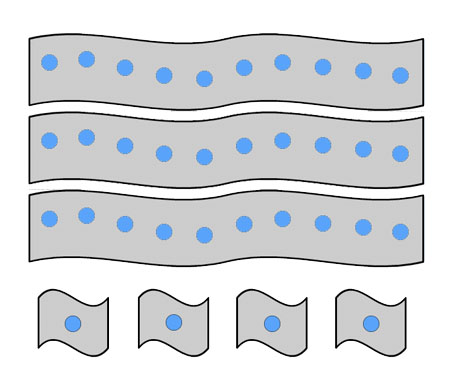4 Decomposition
Decomposition refers to breaking down tens into ones (or hundreds into tens) so that the required subtraction can take place. If you need to pay Rs. 7 as your share of an autorickshaw fare but you only have a Rs. 10 note then you may have to exchange the note for 10 single Rs. 1 coins in order to pay the correct fare. This is decomposition in action!
Sometimes you decompose tens into ones, but you may also need to decompose 100 into tens, or ones into tenths and so on. It will be easier for young students to learn decomposition using tens and ones, but don’t forget to show that it is something that happens for all other parts of the number system.
Activity 2: Decomposition – learning to use the written subtraction algorithm
Preparation
Use strips as in Activity 1. If you did Activity 1 with your students then ask them to bring in their own strips so that you only have to make new strips for those who forget.

Ask the students to work in groups of four or five, and make sure that each group has lots of ‘ten strips’ and a few singles.
The activity
- Ask each group to sort out strips to represent 34 and check that everyone can do this.
- Tell your students they now have to ‘subtract 16 from 34’. Write the subtraction on the board and ask the students to do it using the strips.
- Give them a few minutes to discuss what to do and then ask for suggestions.
- Say to the students that taking away 10 is of course easy, the difficult bit is taking 6 ones away when you only have four ones. Can they think of a way to get more ones? Encourage the students to rip up one tens strip into ten singles if no one has already suggested it, which they may do if they have done Activity 1. Ask: ‘How many singles do you have now? Can you take away 6 now? What is the answer to ‘subtract 16 from 34’? Is that the same as ‘34 take away 16’?’
- Give the students several more examples of subtraction before explaining the formal written subtraction algorithm. They will need to be confident about ripping up or decomposing a ten, and realising that they therefore have one less ten, before they see how this ‘action’ is written down.
- Of course, you could use this method to continue into hundreds, although drawing the dots for two hundred might be tedious (perhaps ask for volunteers to do this during a lunch break). It would be useful though to rip the hundred sheet into tens strips sometimes so that the connection is made.
Video: Talk for learning |
Case Study 2: Mrs Kapur talks about using Activity 2
I had used the strips for Activity 1 several months before and most of my class kept a few strips tucked into the back of their exercise book just in case they needed to ‘see what to do’. I had encouraged them to use the strips so that they felt confident in what they were doing. I know how feeling unsure can stop students enjoying mathematics and ultimately make them think they cannot do it.
I used the number line to show subtraction so that they had the idea of taking away and the number reducing. It was natural therefore for me to use the strips when teaching the formal subtraction algorithm, and so when I asked them to bring in lots of strips themselves they knew it would be worth doing and brought them in.
They had no trouble laying them out and when I asked, ‘What shall we do, we do not have enough ones to take away 6?’ Some of the students replied, ‘Unmake the ten, rip it up!’ So we did, but first I asked some of the children who had quickly understood what to do to explain their thinking to the rest of the class. This was because I felt that quite a few students had not fully understood at this point in the lesson.
Many students needed to use the strips a great deal before they could see immediately what to do. I encouraged them to make up their own sums and to use the strips to show what was happening until I could see that they had developed confidence in what they were doing.
Of course some of them saw it straight away. I asked these students to form a group together and to discuss how this could be written down in the same way that we wrote down our additions formally. This made them think hard and when they were ready they showed the rest of the class their way. It was almost the same as I would have taught them, which delighted me. The only difference was that they talked about taking one ten and ‘ripping it up’ so that it could go in the ones column, but if that is the way they want to talk about it, it is fine by me!
Pause for thought An important part of this activity is the opportunity it provides for students’ to learn through discussion and explaining their thinking. Do you feel that there were any additional opportunities in Mrs Kapur’s lesson for the students to engage in talk for learning? You may want to have a look at the key resource ‘Talk for learning’ to help you think about this. Now reflect on how your students responded to the activity and answer the following questions:
|
3 Ways to demonstrate grouping and decomposition
